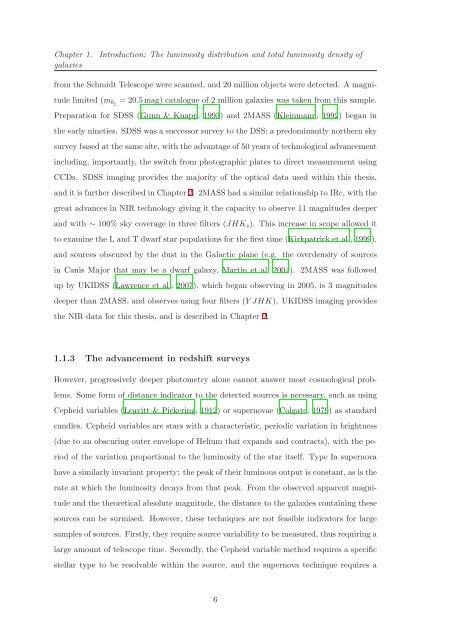David Thomas Hill PhD Thesis - Research@StAndrews:FullText ...
David Thomas Hill PhD Thesis - Research@StAndrews:FullText ...
David Thomas Hill PhD Thesis - Research@StAndrews:FullText ...
You also want an ePaper? Increase the reach of your titles
YUMPU automatically turns print PDFs into web optimized ePapers that Google loves.
Chapter 1. Introduction: The luminosity distribution and total luminosity density of<br />
galaxies<br />
from the Schmidt Telescope were scanned, and 20 million objects were detected. A magni-<br />
tude limited (mbj = 20.5mag) catalogue of 2 million galaxies was taken from this sample.<br />
Preparation for SDSS (Gunn & Knapp, 1993) and 2MASS (Kleinmann, 1992) began in<br />
the early nineties. SDSS was a successor survey to the DSS: a predominantly northern sky<br />
survey based at the same site, with the advantage of 50 years of technological advancement<br />
including, importantly, the switch from photographic plates to direct measurement using<br />
CCDs. SDSS imaging provides the majority of the optical data used within this thesis,<br />
and it is further described in Chapter 2. 2MASS had a similar relationship to IRc, with the<br />
great advances in NIR technology giving it the capacity to observe 11 magnitudes deeper<br />
and with ∼ 100% sky coverage in three filters (JHKs). This increase in scope allowed it<br />
to examine the L and T dwarf star populations for the first time (Kirkpatrick et al., 1999),<br />
and sources obscured by the dust in the Galactic plane (e.g. the overdensity of sources<br />
in Canis Major that may be a dwarf galaxy, Martin et al. 2004). 2MASS was followed<br />
up by UKIDSS (Lawrence et al., 2007), which began observing in 2005, is 3 magnitudes<br />
deeper than 2MASS, and observes using four filters (YJHK). UKIDSS imaging provides<br />
the NIR data for this thesis, and is described in Chapter 2.<br />
1.1.3 The advancement in redshift surveys<br />
However, progressively deeper photometry alone cannot answer most cosmological prob-<br />
lems. Some form of distance indicator to the detected sources is necessary, such as using<br />
Cepheid variables (Leavitt & Pickering, 1912) or supernovae (Colgate, 1979) as standard<br />
candles. Cepheid variables are stars with a characteristic, periodic variation in brightness<br />
(due to an obscuring outer envelope of Helium that expands and contracts), with the pe-<br />
riod of the variation proportional to the luminosity of the star itself. Type Ia supernova<br />
have a similarly invariant property: the peak of their luminous output is constant, as is the<br />
rate at which the luminosity decays from that peak. From the observed apparent magni-<br />
tude and the theoretical absolute magnitude, the distance to the galaxies containing these<br />
sources can be surmised. However, these techniques are not feasible indicators for large<br />
samples of sources. Firstly, they require source variability to be measured, thus requiring a<br />
large amount of telescope time. Secondly, the Cepheid variable method requires a specific<br />
stellar type to be resolvable within the source, and the supernova technique requires a<br />
6

















